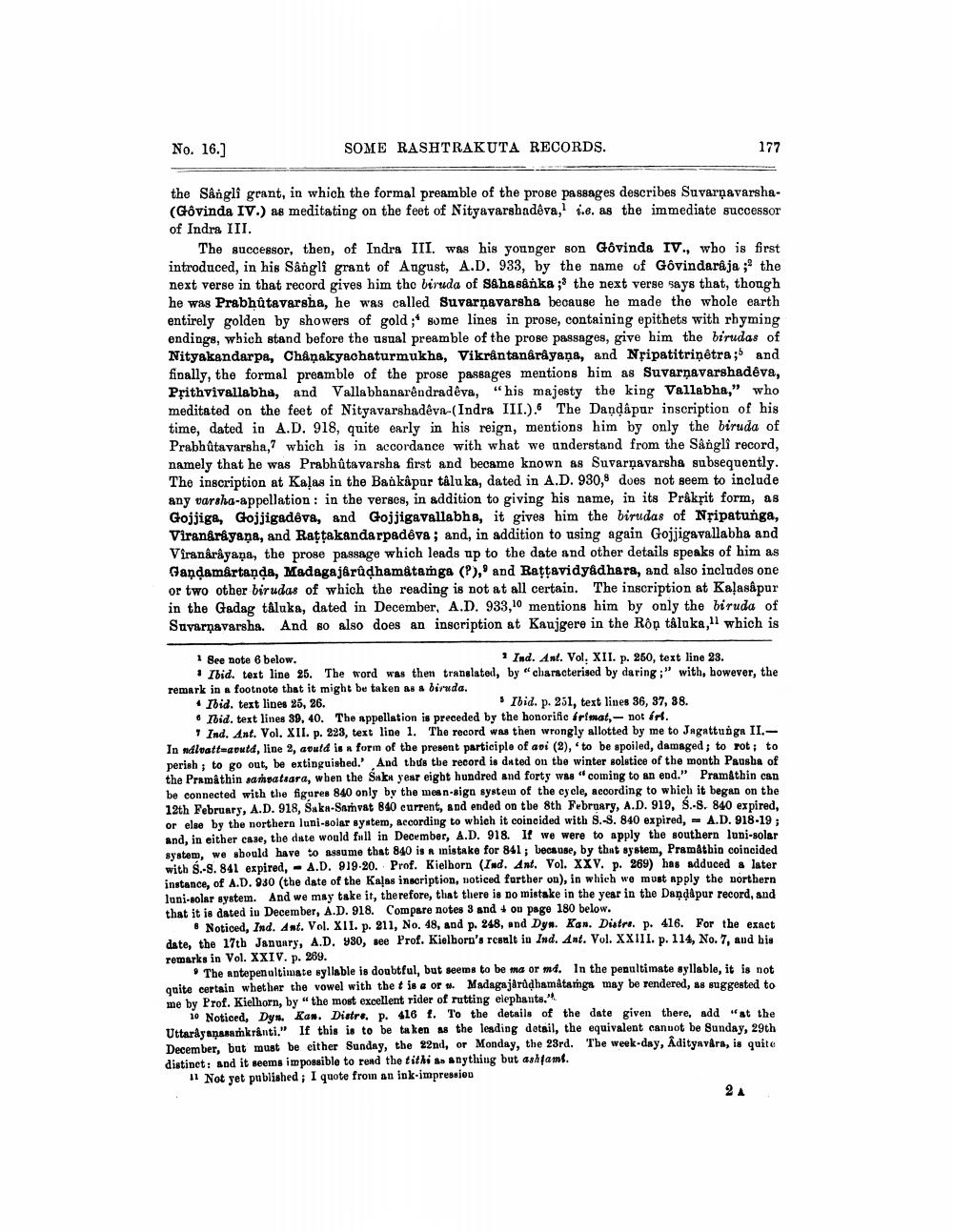________________
No. 16.]
SOME RASHTRAKUTA RECORDS.
177
the Sångli grant, in which the formal preamble of the prose passages describes Suvarņavarsha(Govinda IV.) as meditating on the feet of Nityavarshadêva, 1.e. as the immediate successor of Indra III.
The successor, then, of Indra III. was his younger son Govinda IV., who is first introduced, in his Sangli grant of Angust, A.D. 933, by the name of Govindaraja ;' the next verse in that record gives him the biruda of s&hasanka ;' the next verse says that, though he was Prabhutavarsha, he was called Suvarnavarsha because he made the whole earth entirely golden by showers of gold;" some lines in prose, containing epithets with rhyming endings, which stand before the usual preamble of the prose passages, give him the birudas of Nityakandarpa, Chåņakyachaturmukha, Vikrântanarayana, and Nripatitriņêtra;5 and finally, the formal preamble of the prose passages mentions him as Suvarnavarshadeva, Přithvivallabha, and Vallabhanarendradêva, "his majesty the king Vallabha," who meditated on the feet of Nityavarshadêva-(Indra III.). The Dandapur inscription of his time, dated in A.D. 918, quite early in his reign, mentions him by only the biruda of Prabhůtavarsha, which is in accordance with what we understand from the Sangli record, namely that he was Prabhůtavarsha first and became known as Suvarnavarsha subsequently. The inscription at Kalas in the Bankápar tåluka, dated in A.D. 930,8 does not seem to include any varsha-appellation : in the verses, in addition to giving his name, in its Prakṣit form, as Gojjige, Gojjigadêve, and Gojjigavallabhs, it gives him the birudas of Nripatunga, Viranåråyaņa, and Rattakandarpadêva; and, in addition to using again Gojjigavallabha and Viranåråyaņa, the prose passage which leads up to the date and other details speaks of him as Gaņdamårtanda, Madagajärûdhamåtamga (P), and Rațțavidyadhara, and also includes one or two other birudas of which the reading is not at all certain. The inscription at Kalasapur in the Gadag taluka, dated in December, A.D. 933,10 mentions him by only the biruda of Suvarnavarsha. And so also does an inscription at Kaujgere in the Rôn tâluka, which is
1 See note 6 below.
1 Ind. Ant. Vol. XII. p. 250, text line 23. 1 Ibid. text line 25. The word was then translated, by characterised by daring;" with, however, the remark in a footnote that it might be taken as a diruda. Ibid. text lines 25, 26.
Ibid. p. 251, text lines 36, 37, 38. . Ibid, text lines 39, 40. The appellation is preceded by the honorific frimat, - not in.
1 Ind. Ant. Vol. XII. p. 323, text line 1. The record was then wrongly allotted by me to Jagattunga II.In ndlvattmaruta, line 2, avuld is a form of the present participle of avi (2), 'to be spoiled, damaged; to rot; to perish; to go out, be extinguished.' And thus the record is dated on the winter solstice of the month Pausba of the Pramåthin sampatsara, when the Sukh year eight hundred and forty was "coming to an end." PramAthin can be connected with the figures 840 only by the mean-Bigo system of the cycle, according to which it began on the 12th February, A.D. 918, Suka-Samvat 840 current, and ended on the 8th February, A.D. 919, S.-S. 840 expired, or else by the northern luni-solar system, according to which it coincided with S.-S. 840 expired, - A.D. 918-19; and, in either case, the date would full in December, A.D. 918. If we were to apply the southern luni-solar system, we should have to assume that 840 is a mistake for 841; because, by that system, Pramátbin coincided with s.-S. 841 expired, - A.D. 919-20. Prof. Kielhorn (Ind. Ant. Vol. XXV. p. 269) has adduced a later instance, of A.D. 930 (the date of the Kaļas inscription, noticed farther ou), in which we must apply the northern Juni-solar system. And we may take it, therefore, that there is no mistake in the year in the Dandapur record, and that it is dated in December, A.D. 918. Compare notes 3 and ou Page 180 below.
Noticed, Ind. Ant. Vol. XII. p. 211, No. 48, and p. 248, and Dyn. Kan. Distrs. p. 416. For the exact date, the 17th January, A.D. 990, see Prof. Kielborn's result in Ind. Ant. Vol. XXIII. p. 114, No. 7, and his remarks in Vol. XXIV. p. 289.
The antepenultimate syllable is doubtful, but seems to be ma or md. In the penultimate syllable, it is not guite certain whether the vowel with the tis e or Madagajärůdhamatamga may be rendered, as suggested to me by Prof. Kielhorn, by the most excellent rider of rutting elephants."
1o Noticed, Dyn. Kas. Distre. p. 416 f. To the details of the date given there, add "st the Uttardyanathkranti." If this is to be taken as the leading detail, the equivalent canuot be Sunday, 29th December, but must be either Sunday, the 22nd, or Monday, the 23rd. The week-day, Adityavára, is quite distinct: and it seems impossible to read the tithi & anything but ashame.
11 Not yet published; I quote from an ink-impression




